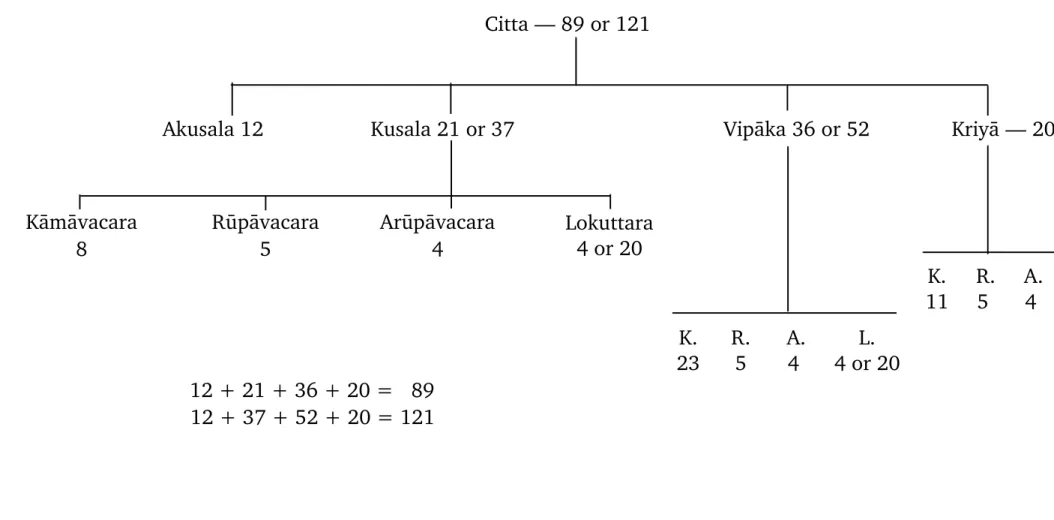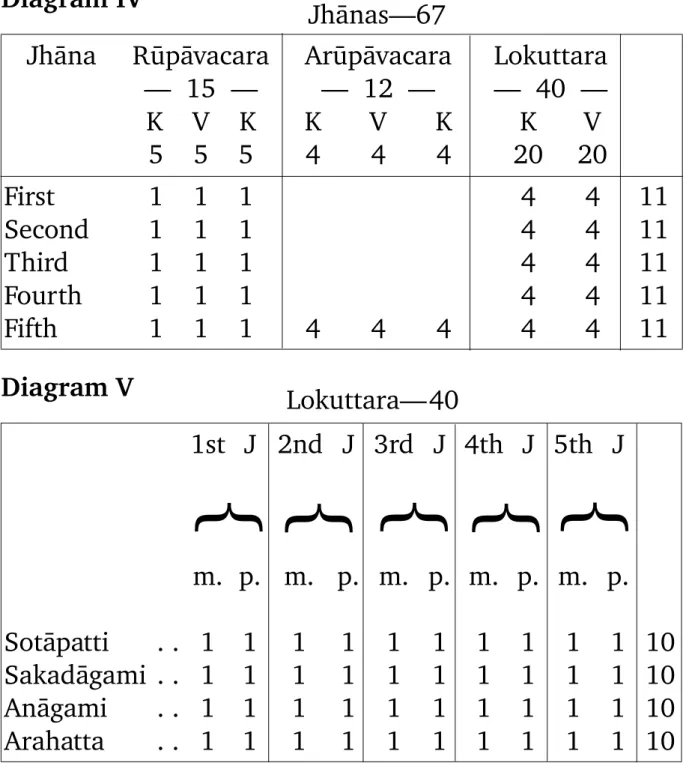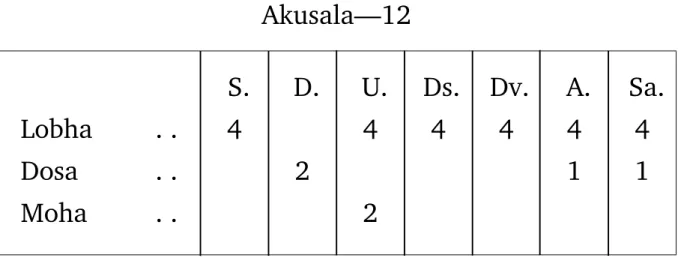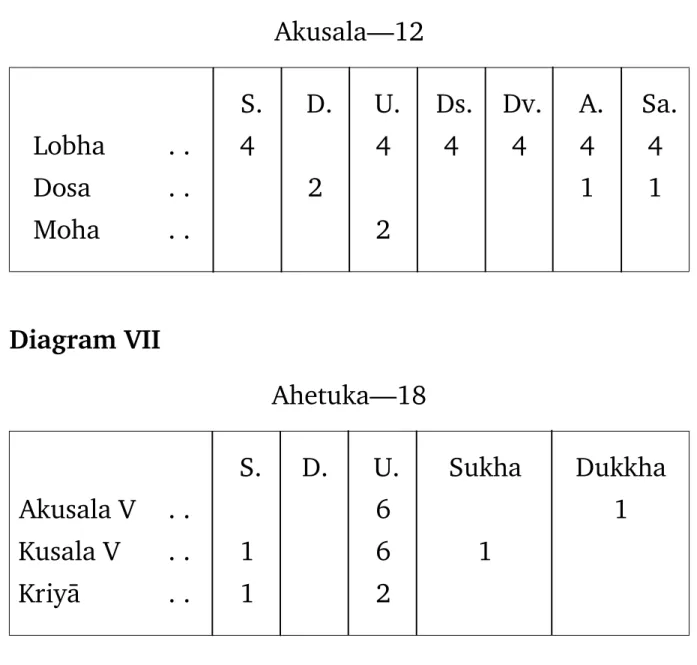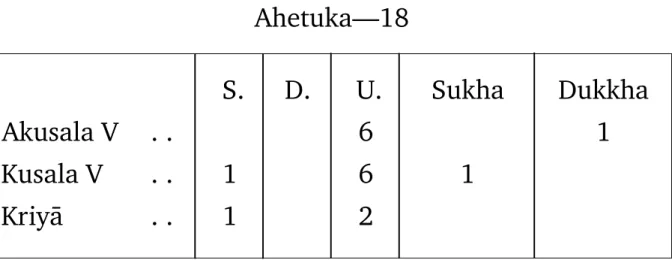The Abhidhamma is the Supreme Teaching of the Buddha, sometimes referred to as the ultimate teaching (paramattha desanà). According to some scholars, the Abhidhamma is not a teaching of the Buddha, but is a later elaboration of scholastic monks.
Abhidhammattha-Saïgaha is the name of the book
Abhidhamma means Higher Doctrine because it enables one to attain one's Salvation or because it transcends the teachings of Sutta Piñaka and Vinaya Piñaka. As it differs according to the method of treatment, it is called Abhidhamma.
The Abhidhamma Piñaka consists of seven treatises—
In the method of exposition this book resembles the Aiguttara Nikàya of the Sutta Piñaka. The importance attached to this treatise, also known as "Mahà Pakaraõa", the Great Book, can be determined by the words of the Atthasàlinã who say: "And while He was considering the contents of the Dhammasaïganã, His body did not rays not emitted, and in like manner with the contemplation of the following five books.
Kàma is either subjective sensual craving or sensuous objects such as forms, sound, odour, taste, and
Råpàvacara, Aråpavacara respectively mean either that which pertains to Råpa and Aråpa Jhànas
Domanassasahagataü, pañighasampayuttaü sasaïkhàrikam ekan’ ti. imàni dve’pi Pañighasampayuttacittàni nàma. imàni dve’ pi Momåhacittàni nàma. A consciousness, incited, accompanied by pleasure and detached from wrong appearance,. from indifference, and connected with the wrong view,.
Akusala, Kusala, Vipàka, Kiriya—
Three Roots (Måla)
Adosa means not only non-anger or non-hatred, but also benevolence, or benevolence, or loving-kindness (mettà). Amoha means not only non-delusion, but also wisdom or knowledge (¤àõa or pa¤¤à).
Vedanà or Feeling
Of the 89 types of consciousness, the remaining 85 involve either a pleasant feeling or a neutral feeling. This is why there is no upekkhà in the case of touch which, according to Abhidhamma, must be either happy or painful.8.
Diññhi—
Saïkhàrika—
In Paticca-Samuppàda it applies to all moral and immoral activities, good and bad thoughts. When sankhàra is used to mean that which is subject to change, sorrow, etc., it is invariably applied to all conditioned things.
Vicikicchà—
For example, if one does an act caused by another, or after much deliberation or premeditation on his part, then it is sa-saïkhàrika. On the other hand, if one does it immediately, without any external or internal prompting, or any premeditation, then it is asaïkhàrika.
Uddhacca—
Reasoning or investigating to understand the truth is not discouraged in Buddhism.
Kusala and Akusala—
Kusala is healthy in the sense of being free from physical and mental ailments through passions. It is used in the sense of physical and mental movement, gentleness, fitness, etc.
Kiriya or Kriyà, literally, means action
The same illustration applies to the third and fourth types of consciousness, with the difference that the stealing takes place without any misconception. Moved by compassion one can do that; yet there is ill will at the moment of killing, because there is some aversion to the object.
Ignorance
In such a case there is the possibility of stealing with the 9th and 10th consciousness types. Lying can be expressed with the first ten types of consciousness; and that also applies to slander.
Hetu is usually rendered by ‘causal condition’
Dvipa¤cavi¤¤àõa—Five pairs of moral and immoral resultant coõsciousness are enumerated here
Sampañicchana is that moment of conscious- ness which accepts or receives an object. Santãraõa is that
Hasituppàda is a Citta peculiar to Arahants
Sammà Sambuddhas smile with one of the two Sobhana Kiriya Cittas, accompanied by wisdom and joy. (3) Vihasita: – laughter with a light sound; (4) Upahasita: – laughter accompanied by the movement of the head, shoulders and arms;
Thought-Process—
They are either one of the two Santaraõa Cittas, accompanied by indifference, mentioned above, or one of the eight Sobhana Vipàka Cittas, described in section 6. Thus end in all the moral, resultant, functional types of consciousness, with Hetus, of the sensuous sphere.
Sobhana—so called because they yield good qualities, and are connected with blameless roots such as
Pàpa is that which leads to misery. Evil or bad is a better rendering than sin which has a Christian outlook
Hetuka— All the Cittas that are to be described hereafter, are called Sahetukas, with Roots, opposed to the
The first moral consciousness of Jhàn together with initial use, prolonged use, joy, happiness and one-pointedness. First Jhàna Consequential Consciousness along with initial application, prolonged application, joy, happiness and one-pointedness.
Råpàvacara—
Aråpaloka is so called because there is no trace of matter in it. The five are Kriyà cittas, experienced only by Buddhas and Arahants in this life or Arahants in the Råpa-sphere.
Jhàna—Saüskrt Dhyàna—
An even more developed form of Vitakka is found in the Path Consciousness (Magga Citta) as Sammà-Saïkappa (Right Thoughts). Here it is used in the sense of sustained application of the mind to the object.
Ekaggatà (eka + agga + tà) lit., one-pointedness
Icc' evaü sabbathà'pi dvàdasa Aråpàvacara—Kusala—. âlambanappabhedhena — catudhà’ruppamànasaü Pu¤¤apàkakriyàbhedà — puna dvàdasadhà ñhitaü. Cusì i dodici tippi di Aråpa Jhàna di a cuscenza murali, cunsequenziali è funziunali venenu à a fine.
Aråpa Jhana—
Again he concentrates on the first Aråpa Jhàna thinking 'Vi¤¤àõaü anantam', 'Infinite is Consciousness' until he develops the second Aråpa Jhàna - "Vi¤¤àõa¤càyatana.". In order to develop the third Aråpa Jhàna - "âki¤ca¤¤à-yatana" - the yogi takes as his goal the first Aråpa Jhàna consciousness and thoughts - "Natthi ki¤ci", "There is nothing."
The Realisation of Nibbàna
Therefore he turns his attention to the contemplation of the dissolution of things (Bhanga ¤àõa). In his next birth he may or may not be aware of the fact that he is a Sotàpanna.
Forty Types of Lokuttara Cittas:—
In the 89 types of consciousness listed in the first chapter, 52 mental states occur to varying degrees. Thus, upon analysis, we see that the first immoral consciousness consists of 19 mental states.
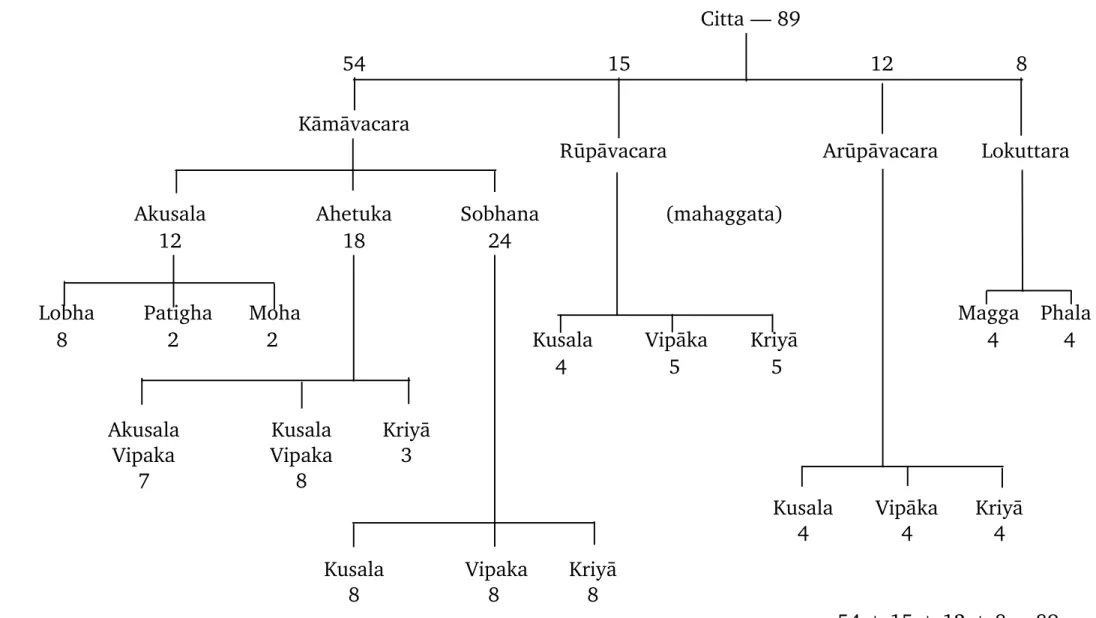
Cetasika = Ceta + s + ika
When an object presents itself to consciousness through one of the six senses, the mental state - contact - arises. According to the commentators, feeling is like a master enjoying a dish prepared by a cook.
Cetanà—
Although Cetanà is also found in the Vipàka types of consciousness, it has no moral significance as it has no accumulative power. It is this Cetanà that is mentioned in Pañicca-Samuppàda as Saïkhàra and (Kamma) Bhava.
Ekaggatà—
Cetanà is considered in every moral and immoral type of everyday consciousness, on the other hand, as Kamma. In the Pa¤cak-khandha, Saïkhàrakkhandha means the fifty spiritual states, excluding Vedanà and Sa¤¤à, with Cetanà as the foremost.
Jãvitindriya—
Soon after, due to the power of Kamma, another Nàma-Jãvitindriya is born in the next birth at the moment of conception. Simultaneously with the birth of one Nàma-Jãvitindriya, three Råpa-Jãvitindriya are born in the case of a human being.38.
Manasikàra—
Mindfulness is the closest equivalent to Manasikàra, although the Pàli term does not fully connote the meaning attached to the English word from a strictly philosophical point of view. Could Manasikàra also be an aid to memory, as it is common to all types of consciousness, whether mundane or supra-oral.
Vitakka—
When developed and cultivated, it becomes the main factor of the First Jhàna. In the later Jhànas, however, Vitakka is rejected because of the usual association with the object.
Vicàra—
Viriya—
Chanda—
Moha—
Ahirika—
Anottappa—
The subjective source of grace is fourfold, viz., the idea of what is due to one's birth, age, worth, and education. The external source of ottappaü is the idea that 'the body of believers will blame you' and therefore one abstains.
Uddhacca—
In a supplementary paragraph the 'points' (consistency etc.) are therefore explained: "In Hiri one reflects on the value of one's birth, one's teacher, one's estate and one's fellow students. The former obscures the object; the latter deals with one's views, such as 'this is indeed truth, and the rest is false'.
Macchariya—
Kukkucca—
As such, it is the opposite of Cittakamma¤¤atà, the adaptability of the mind, one of the Sobhana cetasikas. It is this Sati that is considered one of the factors of the Noble Eightfold Path.
Alobha—
Adosa—
Three Roots of Good:—
Through Alobha there is no sorrow arising from the separation of the beloved, for devotion is the inherent nature. Adosa is the opposite of hatred, through Amoha there is no rebirth in the animal plane.
Tatramajjhattatà—
The main characteristic of Passaddhi is the suppression or allaying of the feverishness of passions (Kilesadaratha-våpasama). It must be understood that Kàya is used in the same sense in the subsequent cetasikas.
Kàya–Lahutà & Citta–Lahutà—
It is like the cool shade of a tree to a person affected by the heat of the sun. It is the body of psychic factors – namely Vedanà (feeling), Sa¤¤à) (perception) and Saïkhàrà (mental states).
Kàya–Mudutà & Citta–Mudutà—
Kàyujjukatà & Cittujjukatà—
All of these 19 companions are common to all types of moral consciousness, unlike immoral companions, which do not arise in immoral consciousness and toto. Along with this 'Beautiful' group, some other moral companions may appear depending on the type of Consciousness.
Virati—
Sammà Vàcà tratta di l'astinenza da u falsu discorsu (Musàvàda), di a calunnia (Pisunavàcà), di u discorsu aspre (Pharusavàcà) è di u discorsu frivulu (Sampapphalàpa). Sammà Kammanta tratta di l'astinenza da l'omicidiu (Pànàtipàta), u furtu (Adinnàdàna) è a cattiva conducta sessuale (Kàmesu Micchàcàra).
Appama¤¤à—
Sammà-Diññhi and Sammà Sankhappa forming Pa¤¤à (Wisdom) are implied with Pa¤¤indriya and Vitakka-Cetasikas respectively. Sammà âjiva deals with abstinence from the sale of poisons, intoxicants, weapons, slaves and animals for slaughter.
Mettà—
Karuõà—
Mudità—
Upekkhà—
Finally, there is the unintelligent indifference of the worldly man who has not conquered limitations or mastered cause and effect, being unable to transcend external things. In this connection he repeats the touching illustration in Hardy (op. cit., 249) of the mother and the four children.
Pa¤¤indriya—
But in the ordinary realm of sense, moral types of consciousness they are present in some cases. Some, however, say that compassion and appreciative joy are not present in the types of consciousness associated with Upekkhà (Equality or Indifference).
Aniyatayogi and Niyatayogi—
In the Fifth Jhàna type of consciousness associated with equanimity, all those except initial application, persistent application, are joy and happiness. So in every respect the synthesis of mental factors arising in the eight types of the supernatural consciousness, according to the five Jhànas, is fivefold.
Abstinences—
Illimitables—
In function thirty-five (in the first pair), twice thirty-four (in the second and third pairs), thirty-three (in the fourth pair). In the result thirty-three (in the first pair), twice thirty-two (in the second and third pairs), thirty-one (in the fourth pair).
Vedanà is a significant mental state which is common to all types of consciousness. Feeling is its char-
Of these, the two types of consciousness (12) related to ignorance have only one root. The point emphasized here is that no immoral roots are found in the higher types of consciousness.
Kicca or Function
The eight great outcomes serve four functions such as reconnection, life continuum, death, and containment. The types of consciousness are declared to be fourteen according to functions such as re-association and so on, and ten according to classification.
Pañisandhi, literally, means re-linking
As such, it is a subconscious state of mind - "below the threshold" of consciousness - by which we imagine continued subjective existence as possible. Whenever the mind does not receive a fresh external object, we experience bhavaïga consciousness.88 Immediately following the thought process, there is also bhavaïga consciousness.
Pa¤cavi¤¤àõa (sense impressions) arise between fivefold cognition (pa¤cadvàràvajjana) and between fivefold cognition (pa¤cadvàràvajjana) and reception of consciousness (sampañicohana).
Sampañicchana arises tween five sense- impressions and investigating consciousness (santãraõa)
Santãraõa arises between receiving-consciousness and determining consciousness (votthapana)
It is so called because during the thought process there are seven thought moments or five running consecutively and hanging on the same object. Manodvàràvajjana is the one who serves this function in the thought process of the five gates.
